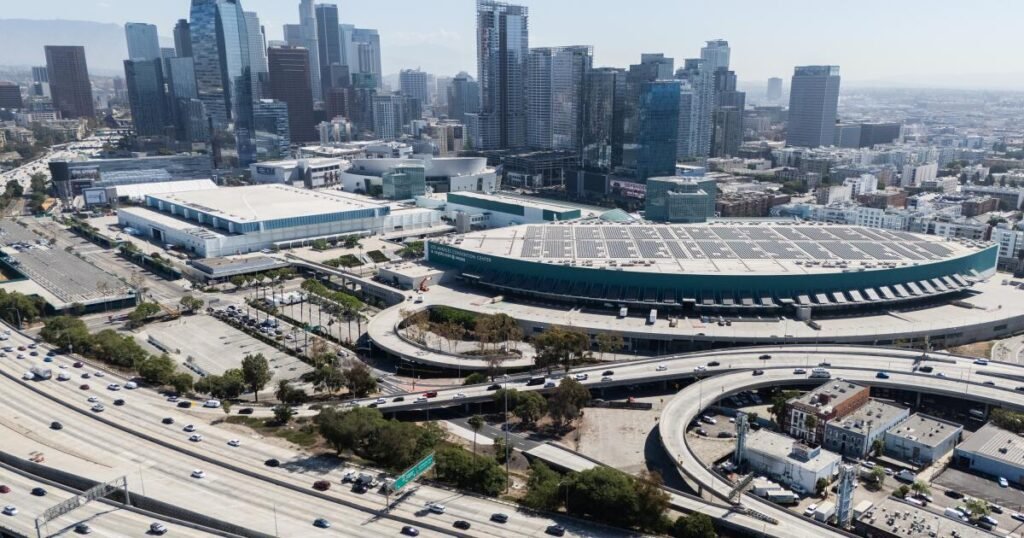Los Angeles Approves Major Expansion of Convention Center
On Friday, political leaders in Los Angeles made a significant commitment, agreeing to invest billions into the aging Convention Center. While they hope this move will invigorate both downtown and the surrounding economy, some experts have labeled it a risky decision.
With an 11-2 vote, the city council greenlit a $2.6 billion expansion despite alerts from advisors indicating that such an investment could divert taxpayer money away from vital city services for many years to come.
The stakes are high. If construction delays occur, there’s a chance that the first phase won’t be completed in time for the 2028 Olympic and Paralympic games, where the center is scheduled to host several events like judo and gymnastics. City policy analysts warn that this could expose the city to financial penalties from the organizing committees.
Nevertheless, Mayor Karen Bass and most council members were undeterred. Bass spoke about the potential for the project to generate thousands of jobs, enhance tourism, and make L.A. more competitive nationally.
Adlin Nazarian, representing the San Fernando Valley, emphasized the importance of believing in the city: “If we don’t invest in ourselves today, how can we expect global investors to come?”
On the other hand, Councillor Traci Park, who leads the Council’s Committee on Tourism and Trade, expressed serious concerns about the city’s economic position. Yet, she also asserted that the project is essential for meeting upcoming Olympic needs. “We need to bring our city back to life. There’s no time to wait,” she declared.
Critics argue that this expansive project is too costly for a city currently facing a budget crisis, having cut 1,600 municipal jobs earlier this year while also deferring employment for the Los Angeles Police Department.
Before the vote, city controller Kenneth Meziah voiced his opposition, claiming that the city’s budget would not see positive revenue until the late 2050s. “There’s no real solution for our financial issues,” he cautioned, indicating that the current plans are not advisable.
The cost of the Convention Center expansion has fluctuated significantly over the past month, with recent estimates showing a reduction of nearly $100 million. City manager Matt Sabo attributed this change to lower borrowing costs and additional expected revenue from digital signs.
Taxpayers will likely bear an average cost of around $89 million annually over the next 30 years. In the early years, from 2030 to 2046, the project is projected to draw at least $100 million from the city’s general fund, which is crucial for funding services like fire and police.
During the council session, Szabo described the decision regarding the expansion as a significant judgment call. “It offers economic benefits, yes. But can you afford it? Yes, but at a cost,” he acknowledged.
Earlier in the week, some opponents had pushed for a more affordable alternative focusing on repairs rather than a complete overhaul, but the Council chose to ignore this proposal, with Councillor Katy Yaroslavsky at the forefront of the opposition. She criticized the plan as too expensive and warned it would lead to a decrease in urban services.
Yaroslavsky and Councillor Nitya Raman, who also voted against the expansion, expressed concerns about the city’s precarious financial situation, stating that while a new convention center might look appealing, it could exacerbate existing issues like homelessness.
This vote marks the culmination of discussions regarding the Convention Center that have spanned over a decade. Plans for upgrades and the addition of hotels have been on the table before.
The expansion project aims to add approximately 325,000 square feet, connecting new and existing facilities. A new structure will even be built over Pico Boulevard, a move described as complex and costly.
The Southern California Construction Workers Union has strongly endorsed the project, advocating for it both publicly and privately, as it promises to create around 2,150 permanent jobs, in addition to thousands of construction positions.
Support for the project also comes from local business groups, who believe it will help revitalize Downtown, which has struggled post-pandemic. They argue that improved facilities will attract national events and draw in more visitors.
Councillor Bob Blumenfield, who couldn’t attend the meeting due to prior commitments, expressed concerns that the project might not be completed in time for the 2028 games. “If that doesn’t happen, it would be embarrassing and financially risky for the city,” he stated.
This week, Blumenfield had joined his colleagues in suggesting a less expensive alternative, but he later shifted to support the expansion. Councillor Eunisses Hernandez also acknowledged her discontent with city services, expressing a commitment to find additional funding. “We can’t keep relying on our members to foot the bill,” she argued.
With a tight timeline, construction is slated to begin very soon, with crews expected to start demolition next month.
Ernesto Medrano, head of the Los Angeles/Orange County Construction Trade Council, emphasized that the project signifies an important investment in local labor. “Our members are ready to get started,” he remarked.







